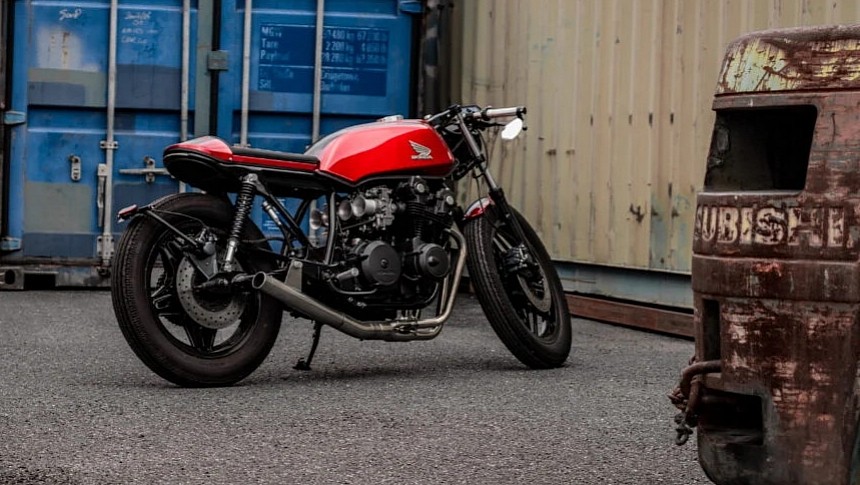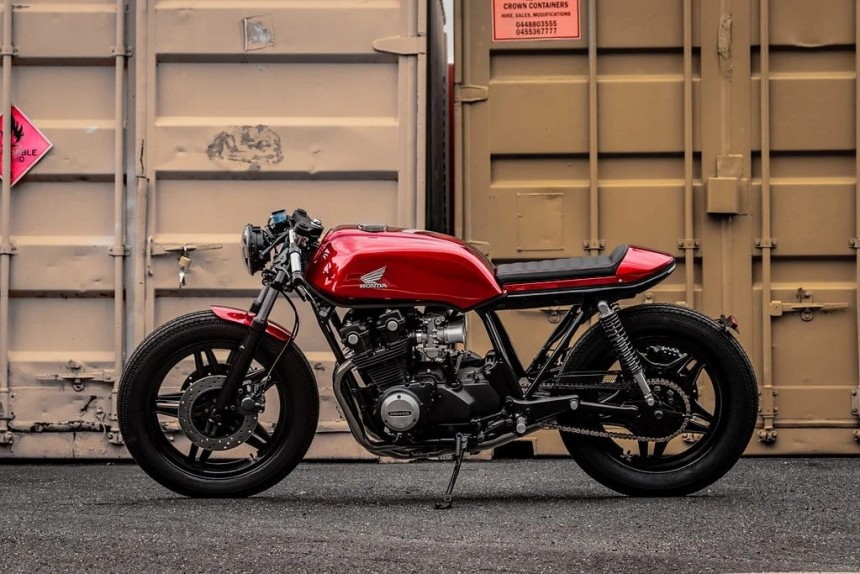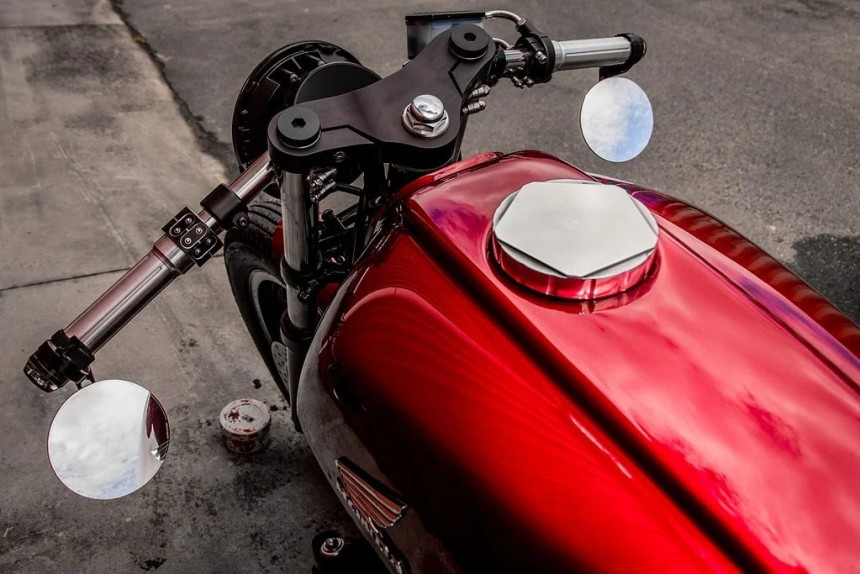Objectively speaking, the Honda CB750F is a better motorcycle than its SOHC forerunner in just about every technical way. Collectors and everyday aficionados would much rather have an iconic first-gen model, though, because its allure simply cannot be matched by the boxier iterations that followed. Oh, and although cosmetic preferences are subjective, the CB750 Four is arguably the prettier bike.
That being said, its DOHC-equipped successor does become the preferred option when it comes to a custom project. Aside from the model’s superior performance, it’ll also cost you a lot less than the sought-after variants from earlier on, and you certainly won’t feel as bad about having it modified irreversibly. What’s more, the CB750F can really become a fantastic one-off in the right hands.
Take, for instance, this delicious cafe racer built by JAX Garage of Melbourne, Australia. As an in-house venture over which customer commissions had priority, it was the sort of project you’d refer to as a back burner. In fact, the donor bike – a 1981 MY CB750F – made its way to the shop right after JAX was founded by Jas Babalija in 2019, but it only attained its final form around four years later.
Perseverance is said to pay off, however, and that was most definitely the case with this custom showstopper! Although you will immediately be able to recognize it as a Honda CB750F, the Aussies worked wonders in reducing visual bulk and taking its cosmetic appeal to new heights. Without further ado, let’s dive in and have a gander at how they’ve achieved this.
Once the Japanese classic had been taken apart, JAX went about performing a good bit of frame surgery, with the intent of creating a straighter cafe-style bone line. The subframe got shortened and then looped, while every piece of stock bodywork aside from the fuel tank was promptly deleted altogether. Atop the modified rear skeleton lies an aluminum seat pan and tail section combo which oozes cafe racer vibes.
As for the groovy, red-stitched solo saddle placed above, it is the only component on this machine that hasn’t been fashioned in-house. Underneath the seat pan, you will now find a tailor-made electronics tray hosting Motogadget’s mo.Unit Blue control module and a compact Antigravity lithium-ion battery, among other items. The electrics are mated to a fresh wiring harness made from scratch, and there’s an LED strip taking care of lighting duties at the rear.
On the other end, we notice a seven-inch Stedi headlamp replacing the stock part, with Motogadget bar-end turn signals joining it a little further back. The blinkers have been attached to clip-on handlebars, which are also outfitted with custom billet aluminum grips, unobtrusive switches, and glassless bar-end mirrors. Besides these goodies, the CB750F’s cockpit features a bespoke, CNC-machined top clamp and digital aftermarket instrumentation, as well.
Furthermore, an RFID keyless ignition setup keeps things looking as clean as possible. The motorcycle’s ergonomic package is completed by a set of billet foot pegs, while its OEM front fender got ditched to make room for a much smaller alternative. This unit declutters the front end considerably, but it’s just large enough to keep road debris off the rider.
In order to achieve the same clutter-free effect at the back, JAX attached a minimalistic license plate holder to the rear brake caliper. The said bracket sits nice and low so as to not interfere with the tail, and it carries the rear LED turn signals, too. On top of the stock gas tank, Sir Babalija’s experts also installed a new filler cap made of aluminum.
Handling is significantly improved thanks to an array of suspension upgrades – progressive fork springs at the front and high-grade aftermarket shock absorbers at six o’clock. The factory Comstar wheels have been kept in play, but their rims are now enveloped in E270 Super Classic tires supplied by Shinkp. Not only does this rubber provide plenty of grip to work with, but it also scores rather well in terms of looks.
Ample stopping power comes by way of drilled brake discs on both ends. The powertrain adjustments were limited to the intake and exhaust, giving the CB750’s inline-four motor some additional grunt without making things too complicated. Gone are the standard Keihin carburetors, and a set of Mikuni RS34 flat slide inhalers have been fitted in their stead. On the exhaust side of the equation, you’ll see premium four-into-one Delkevic pipework exiting toward the right.
Last but not least, there’s the seductive red colorway laid on top of the CB750F’s attire. JAX Garage refers to this gorgeous hue as Soul Red, and it’s been skillfully applied by the shop owner’s father-in-law. Black was the color of choice for the frame, wheels, and most engine covers, with polished metal surfaces breaking things up here and there. In conclusion, we’d pick this caffeinated beauty over its stock counterpart any day!
Take, for instance, this delicious cafe racer built by JAX Garage of Melbourne, Australia. As an in-house venture over which customer commissions had priority, it was the sort of project you’d refer to as a back burner. In fact, the donor bike – a 1981 MY CB750F – made its way to the shop right after JAX was founded by Jas Babalija in 2019, but it only attained its final form around four years later.
Perseverance is said to pay off, however, and that was most definitely the case with this custom showstopper! Although you will immediately be able to recognize it as a Honda CB750F, the Aussies worked wonders in reducing visual bulk and taking its cosmetic appeal to new heights. Without further ado, let’s dive in and have a gander at how they’ve achieved this.
Once the Japanese classic had been taken apart, JAX went about performing a good bit of frame surgery, with the intent of creating a straighter cafe-style bone line. The subframe got shortened and then looped, while every piece of stock bodywork aside from the fuel tank was promptly deleted altogether. Atop the modified rear skeleton lies an aluminum seat pan and tail section combo which oozes cafe racer vibes.
On the other end, we notice a seven-inch Stedi headlamp replacing the stock part, with Motogadget bar-end turn signals joining it a little further back. The blinkers have been attached to clip-on handlebars, which are also outfitted with custom billet aluminum grips, unobtrusive switches, and glassless bar-end mirrors. Besides these goodies, the CB750F’s cockpit features a bespoke, CNC-machined top clamp and digital aftermarket instrumentation, as well.
Furthermore, an RFID keyless ignition setup keeps things looking as clean as possible. The motorcycle’s ergonomic package is completed by a set of billet foot pegs, while its OEM front fender got ditched to make room for a much smaller alternative. This unit declutters the front end considerably, but it’s just large enough to keep road debris off the rider.
Handling is significantly improved thanks to an array of suspension upgrades – progressive fork springs at the front and high-grade aftermarket shock absorbers at six o’clock. The factory Comstar wheels have been kept in play, but their rims are now enveloped in E270 Super Classic tires supplied by Shinkp. Not only does this rubber provide plenty of grip to work with, but it also scores rather well in terms of looks.
Ample stopping power comes by way of drilled brake discs on both ends. The powertrain adjustments were limited to the intake and exhaust, giving the CB750’s inline-four motor some additional grunt without making things too complicated. Gone are the standard Keihin carburetors, and a set of Mikuni RS34 flat slide inhalers have been fitted in their stead. On the exhaust side of the equation, you’ll see premium four-into-one Delkevic pipework exiting toward the right.
Last but not least, there’s the seductive red colorway laid on top of the CB750F’s attire. JAX Garage refers to this gorgeous hue as Soul Red, and it’s been skillfully applied by the shop owner’s father-in-law. Black was the color of choice for the frame, wheels, and most engine covers, with polished metal surfaces breaking things up here and there. In conclusion, we’d pick this caffeinated beauty over its stock counterpart any day!

















